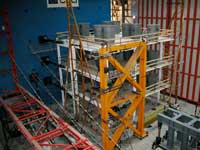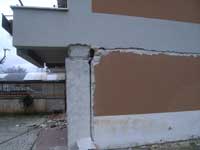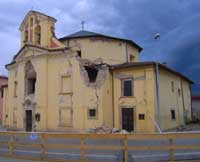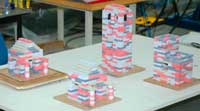Combating earthquakes: designing and testing anti-seismic buildings Understand article
Earthquakes can be devastating. Is there anything we can do to resist them? Francesco Marazzi and Daniel Tirelli explain how earthquake-proof buildings are designed and tested.

Click to enlarge image
Image courtesy of the
Global Seismic Hazard Program
On 3 February 2010 in Haiti, approximately 200 000 people were killed and 280 000 buildings collapsed or were severely damaged by an earthquake. Closer to home – in Abruzzi, Italy – an earthquake in the early morning of 6 April 2009 caused more than 300 deaths and prompted the evacuation of 60 000 people.
Because they are the consequence of tectonic motions, earthquakes cannot be controlled or easily predicted; we can only analyse the intensity and frequency of earthquakes statistically (for more information, see Latchman, 2009). For a given region, the expected intensity of earthquakes is inversely proportional to their frequency of occurrence: minor earthquakes are more frequent than strong ones.
Although we cannot escape earthquakes, we can resist them, for example by designing earthquake-proof – or anti-seismic – buildings.
An earthquake is a ground motion characterised by oscillations in three dimensions; the effects of this motion on buildings can be considerable. Earthquakes cause buildings to move very rapidly; the building’s mass multiplied by the acceleration caused by the earthquake produces very large forces, as described by Newton’s second law of motion (force = mass x acceleration). Because houses and other common structures are designed to support their own weight, they can usually resist the additional vertical forces caused by the vertical movements of the earthquake. Horizontal forces, however, are often underestimated or overlooked during the design phase, so buildings may collapse when subjected to an earthquake.
For economic and practical reasons, anti-seismic buildings need to have appropriate levels of earthquake resistance: even the strongest earthquake should not cause the building to collapse, although a certain level of damage would be acceptable. A minor earthquake, in contrast, should not cause even minor damage, such as repairable cracks. The design of an anti-seismic building should also take into account its importance and function: a hospital or a fire station, for example, must remain operative even after the strongest earthquake.

a shaking table (left) and a
reaction wall and strong floor
system (right)
Image courtesy of ELSA
Despite the enormous progress in computer modelling and simulation of buildings’ responses to earthquakes, experimental testing is still an important part of the development of anti-seismic buildings. Engineers use small- or full-scale models to investigate a structure’s response to an earthquake: how safe would the building be in an earthquake and how could it be improved?
There are currently two complementary experimental techniques to simulate the effect of an earthquake on a structure: one based on the shaking table and the other on the reaction wall and strong floor system (see image above). A shaking table is a platform that mimics an earthquake by producing vibrations in one, two or three dimensions. The test building – normally a scaled-down model – is placed on the shaking table and exposed to the ‘earthquake’ and the effect is noted. Does the building fall down? Do cracks appear in the walls? How does the damage occur? How long an earthquake can the building withstand? The drawback of this simulation is that it cannot be halted partway through the ‘earthquake’: only the final damage can be assessed.

-scale 3D building
Image courtesy of ELSA
The reaction wall and strong floor system, in contrast, allows full-scale buildings to be tested. The building is placed on the floor of the system and hydraulic arms attached to the reaction wall exert pressure on the building, corresponding to an earthquake. The earthquake can be simulated in slow motion – a real-life earthquake lasting only a few seconds can take hours to simulate. This allows the damage to the building to be closely monitored; the test can be paused for engineers to examine the building more closely or to prevent it from collapsing completely. Sensors record the effects of the simulated earthquake on the building, including deformation, stress, inclinations and force.
Europe’s largest reaction wall and strong floor system is at the European Laboratory for Structural Assessment (ELSA)w1, where it is used to test ways in which large-scale structures (such as bridges and buildings) can be strengthened and repaired.
As can be demonstrated experimentally, the likely damage caused by an earthquake to a building (its seismic vulnerability) can be reduced in several ways. One is to separate the building from the ground, so that vibrations caused by the earthquake are not transmitted to the building.
Base isolation, for example, involves introducing a sliding system between the foundation and the lower part of the building. Another approach is to concentrate the damage in pre-defined parts of the structure: this allows the dissipation of the earthquake’s energy and prevents unexpected behaviour. For example, if iron parts are inserted at structural nodes (e.g. where beams are connected to columns), these pieces will be deformed during the earthquake instead of the building itself.

would have helped this house
in L’Aquila to withstand the
earthquake in 2009
Image courtesy of Francesco Marazz

, L’Aquila, Italy
Image courtesy of Fabio Taucer
The design of a building is extremely important. Regular designs, for example, are more resistant to earthquakes than irregular ones because they are less subject to torsional effects (twisting) and thus to local stresses and deformations. Smaller details are also very important. Walls should be well connected to each other and to the floors, making the house resist the earthquake as a whole (the structure is said to exhibit ‘box behaviour’). In old masonry houses, inserting tie-rods at floor level links the structural walls and the floor together, so that they function as a single element, sharing deformations and stresses. This improves the overall energy dissipation capacity of the building. In new buildings, concrete elements may be held firmly together by ‘close confinement stirrups’; this significantly improves the earthquake resistance of the building at a negligible cost.
Anti-seismic devices are important not only to save lives but also to protect our cultural heritage: ELSA carried out tests on a full-scale model of part of the monastery of Saõ Vicente de Fora in Lisbon, Portugal, and on a half-scale reconstructed façade of the Palazzo Geraci in Palermo, Italy. As a result of these tests, ELSA was able to contribute to general guidelines for protecting historic monuments from earthquake damage.
School activities at ELSA
ELSA has an interactive laboratory for children, which includes a small shaking table; as it can be easily transported, shaking-table demonstrations can be conducted either during school visits to ELSA, in Ispra, Italy, or directly in schools (see Anthoine et al., 2010).

Image courtesy of Francesco Marazzi
A demonstration of the principles of structural dynamics first introduces children to concepts such as natural frequency, mode shape and vibration, and to the basic ideas of sensors and data collection. The students are then invited to assemble structures made of special stone bricks and to test them on the shaking table. They can give free rein to their imagination: some houses have several doors and windows, while others are more similar to bunkers, pyramids or Greek temples.
The model houses are then placed on the shaking table and exposed to a simulation of a real, recorded earthquake. The students are asked to describe what they observe and to explain why houses behave differently when subjected to the same earthquake. This introduces the concept of seismic risk: the combination of seismic vulnerability (how sensitive the house is to earthquakes) and seismic hazard (how strong is the largest earthquake expected in a given location). The only way to reduce the seismic risk is to reduce the vulnerability; we have no power over hazard!
One of the most effective methods for reducing vulnerability – base isolation – can be seen on our little shaking table, which has three rolling tubes of small radius supporting the base of the model. These tubes separate the building from the ground and ensure that vibrations from an earthquake are not transmitted upward. The effectiveness of this system is easily shown when two identical models, one with base isolation and the other without, are tested at the same time: the earthquake will destroy the non-isolated building whereas the other will remain intact.
References
- Anthoine D, Marazzi F, Tirelli D (2010) Introducing students to structural dynamics and earthquake engineering. Physics Education 45, 76-82. doi: 10.1088/0031-9120/45/1/009
- Latchman S (2009) Modelling catastrophes. Plus Magazine 53. http://plus.maths.org/issue53/features/latchman
Web References
- w1 – For more information about ELSA, visit: http://elsa.jrc.ec.europa.eu
- w2 – To learn more about the Eurocodes, see: http://eurocodes.jrc.ec.europa.eu
Resources
- Kirschbaum T, Janzen U (2006) Tracing earthquakes: seismology in the classroom. Science in School 1: 41-43. www.scienceinschool.org/2006/issue1/earthquakes
- The United Nations International Strategy for Disaster Reduction has developed an online disaster simulation game (Stop Disasters!). See: www.stopdisastersgame.org
- The BBC website has some good animations about earthquakes. See: http://news.bbc.co.uk/2/hi/4126809.stm
- The website of the United States Geological Survey’s Earthquake Hazards Program has very extensive information about earthquakes, including animations. See: http://earthquake.usgs.gov/earthquakes
- For a video (Demonstration of Friuli Earthquake effects on buildings) recorded at ELSA, see: http://elsa.jrc.ec.europa.eu/publications/Friuli1976_2.wmv
- Available on Google books, this is a technical but clear explanation of the main aspects of seismic engineering: Committee on Earthquake Engineering Research (1982) Earthquake Engineering Research – 1982. Washington DC, USA: National Academy Press. http://books.google.it
- For a collection of photographs of earthquake-damaged structures, with a very brief explanation of how the damage happened, see the Earthquake Engineering Slide Information System website: http://www.ikpir.com/easy/html/ang/INDEX.HTM
- For a list of the main earthquakes in Italy (as an example), see: http://en.wikipedia.org/wiki/List_of_earthquakes_in_Italy
- For more information about earthquakes, see also the main Wikipedia page on this topic: http://en.wikipedia.org/wiki/Earthquake
Review
The article is particularly interesting because it explains clearly what is being done to design and test earthquake-proof buildings. The article can be used as an introduction to the topic of general waves or seismic waves in physics and in geography lessons. It is ideal for introducing the theme of earthquakes because it explains their nature and shows why severe damage occurs to buildings as a result of Newton’s laws. It could be used to start a discussion about the destruction caused by earthquakes, their impact on society and what can be done to limit the damage.
Moreover, this article provides valuable background reading and recommends websites to make students aware of how science can benefit society. It also makes both students and teachers aware of scientific organisations such as ELSA that work to enhance the safety of citizens. Sometimes we tend to get lost in formulae and theories and treat science as a purely academic subject. This article, however, gives a concrete example of how the science studied in class is applied in real situations, such as earthquakes, which unfortunately lately have occurred in various countries, creating destruction and havoc.
The article could be used as a comprehension exercise for subjects in which earthquakes are part of the syllabus or if earthquakes (not specifically part of the syllabus) are used to discuss waves. Suitable questions include:
- What is an earthquake?
- With reference to Newton’s second law of motion, why is the force acting on a building so large during an earthquake?
- Name two techniques used to test anti-seismic buildings. Explain briefly how these work.
- In view of the natural disasters that have devastated some countries recently, do you think that these techniques should be used more widely? Explain your answer.
The article could be used in different ways for different age groups:
10-12: to give a general description of what an earthquake is and keep the students informed about what is happening in European and other countries.
12-15: to introduce the topic of earthquakes and inform students of their nature and how they occur. The article could also be used to demonstrate that a whole branch of science is dedicated to studying these events and minimising their effects.
16+: to introduce the topic, which could then lead to a more detailed study of seismic waves. The article could also show how science is used for the benefit of citizens. Moreover, students could discuss how countries deal with earthquakes and understand how the science studied in class is applied in real contexts.
Catherine Cutajar, Malta





